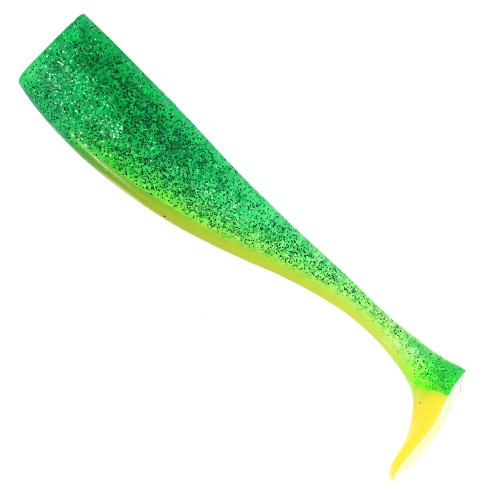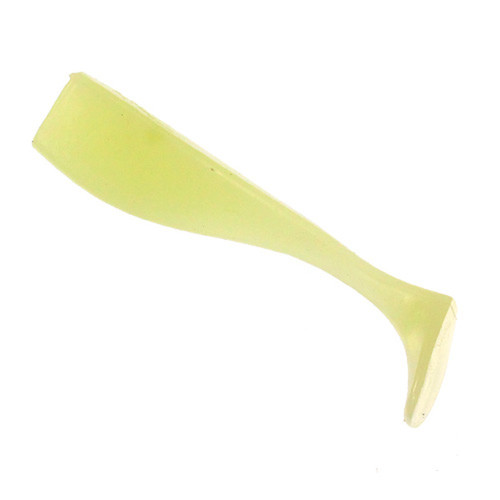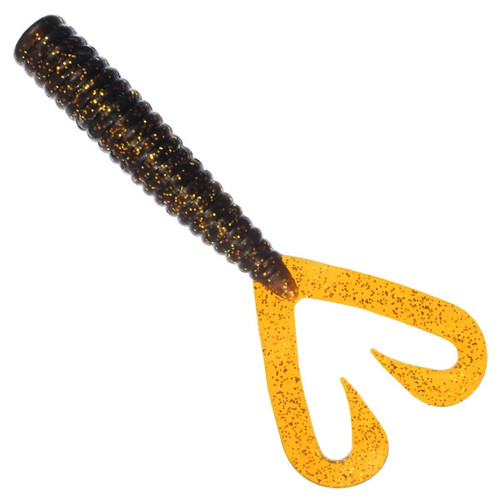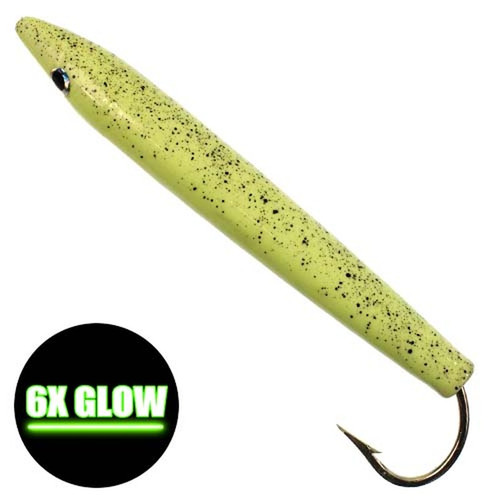- A Revolutionary Step Forward in Plastic Swimbaits -
One of the most popular lures for bottomfish and other hungry predators, the Pitbull Tackle UV Hot Tail Swimbaits were designed to take swimbait fishing to the next level. Not only are these swimbaits offered in proven fish catching colors, but every Hot Tail swimbait is enhanced with Ultra-Violet (UV) colors both in the body of the bait as well as the underside belly/tail or "Hot Tail". This ensures that no matter where you're fishing them, these baits will be the brightest and most visible in the water. Every Hot Tail comes standard with a molded hollow hook guide through the center body of the bait which allows for straight and simple rigging every time; say goodbye to kinked and uneven swimbaits. Another feature which Pitbull Tackle designers included was the choice of plastic. Too often do hungry predators take a toll on soft plastic lures. There is nothing more frustrating than going through swimbait after swimbait as they tear or rip apart while fishing. The designers for the Hot Tails had this in mind as they created these baits from an ultra-durable plastic to ensure longevity in each bait. This unique plastic still allows for plenty of flexibility, and is complimented by a narrow section just before the over-sized tail which provides maximum kicking action through the water. When all of these factors are considered, it is easy to see why the Pitbull Tackle UV Hot Tail Swimbaits are a must-have in any anglers tackle box.
Pitbull Tackle UV Shad Jig Heads
Want to create the ultimate color-matched swimbait presentation like the one shown below? Pitbull Tackle also offers UV-enhanced jigheads which are designed to perfectly pair with the Hot Tails. Check out the UV Shad Jig Heads HERE
How To Fish:
Rigging the UV Hot Tail Swimbait:
- Begin by threading the hook point through the hollow channel entrance hole in the front of the bait
- The hook point will slide through the channel until it reaches the back of the channel. At this point, slide the hook point through the top of the swimbait body
- With light pressure, continue to thread the swimbait onto the jighead by pushing the front of the swimbait to the flat surface on the backside of the jighead
- The swimbait should sit flush on the jighead. This process can be repeated with all Pitbull Tackle Swimbaits
Fishing the Hot Tail UV Swimbaits:
Vertical Jigging:
This technique is utilized when fishing off a boat, typically fished by dropping lures straight down to the strike zone and reeling back up.
The Pitbull Tackle UV Hot Tail Swimbaits are very simple to fish. Simply rig the swimbait on an appropriately sized jighead using the hook-channel rigging system and you are ready to fish. Freespool the swimbait to the bottom, keeping slight pressure on the reel's spool as to not backlash on the way down. Once on bottom, raise and lower the rod tip to jig the swimbait. The combination of the large tail kicking and the thud of the jighead hitting the bottom entices fish from all over. This works well on slow drifts, when it is easier to keep the line vertical which prevents snagging on the bottom. If the drift is faster, doing short casts up towards the direction of the drift can help offset the movement of the boat and will help the bait be fished effectively for a little longer. Letting the line get too much of an angle and pendulum away from the boat typically results in a higher chance of hanging up on the bottom or tangling with other anglers' lines. Keeping your line as straight up and down as possible is your best bet for effectively fishing swimbaits of this category. Adjusting jighead size is also a major factor in maintaining vertical line while drifting. Using a heavier jighead during a faster drift will help you to feel the bottom better and allow the line to stay vertical longer. Oftentimes fish will bite as the swimbait is falling back to the bottom, so make sure to remain aware of the rod tip and the feel of the lure while in the strike zone. Using braid or braid to a leader is recommended as this will increase sensitivity through the rod and allow you to feel the subtle bites, especially when fishing in deeper water. This is one of the best ways to target a huge variety of bottom-dwelling hunters predators.
Swimbait Casting:
Another popular way to fish swimbaits is a cast and retrieve method. This method is extremely diverse and is effective for almost any predatory fish.
Bank Fishing: Swimbaits are an excellent way to cover water quickly, especially from the bank. Rock jetties are a perfect spot to target all sorts of inshore species with swimbaits. Casting down the jetty parallel to the bank and bringing the swimbait up over the rocks can be a deadly effective way to target fish which may be in the rocks ready to ambush prey as it passes by. Making a long cast and barely ticking the swimbait over the tops of the rocks is a great strategy to trigger bites up and down the coast. Some anglers also approach fishing jetties by targeting the large holes between the rocks where fish may be hiding. Nothing catches a hungry fish faster than dropping a swimbait right in front of its face. If fishing along the rocks is not successful, try slowing down and strategically pitching your swimbait into the holes and caves along the rocks. When the fish bites it can easily become snagged in the rocks, so reel quickly to get the fish out of the hole and into more open water. A stout rod is typically preferred to be able to turn the fish in the direction you want as well as to flip the fish out of the water and onto land.
Fishing swimbaits on the bottom is also a great way to catch all sorts of fish including Rockfish, Halibut, Stripers, and many others. Oftentimes tidal movements around jetties, bays, and beaches can create vast sand flats which is perfect habitat for fish to lie and wait for prey. Making long casts and bringing the swimbait along the bottom can cover water quickly as well as trigger reaction strikes from hungry fish. If the sandy bottom has sparse rocks mixed in, even better. Choosing the right jighead size is key when fishing the shore. In most situations, the correct jighead weight is one that is heavy enough to maintain bottom contact but not overly heavy where snagging becomes too frequent. Tidal movement can also play a role in the size of the jighead you are using, so it is usually a good idea to try a few different sizes to fine-tune your technique to the area in which you are fishing.
Nearshore Fishing: Oftentimes fish will be suspended up off the bottom, making it a little more difficult to target them. Schooling bottomfish such as Black and Blue Rockfish as well as warmer water species such as Calico Bass oftentimes suspend off the bottom. Kelp beds are a particularly effective place to start. Not only does kelp offer cover from above, but the plants also have long stems which reach down to the bottom with multiple branches sprouting off, giving predators plenty of cover to ambush baitfish. Placing the boat on the outside of the kelp and casting in towards the bed itself is a good start. Cast towards the kelp and let the swimbait fall. Fish sometimes tend to follow the swimbait on its decent and will bite as it is falling. Depending on how deep you are fishing you may not need to let the bait fall all the way to the bottom. Varying your retrieve to find which action is best for the current conditions is the best way to effectively break down the area and have the most productive day. Some fish may want the bait "burned" or reeled quickly near the surface, other times fish may want the bait swimming slowly near the bottom. Let the fish dictate to you what they want, and once the bites begin to become more consistent stick with that style of retrieve.
Specifications:
- The Pitbull Tackle UV Hot Tails come in three sizes: 5" 6" & 8"
- All swimbaits have the integrated hook-channel guide for easy-rigging
![]() WARNING: This product can expose you to chemicals including Di(2-ethylhexyl)phthalate (DHEP) and lead, which are known to the State of California to cause cancer, and birth defects or other reproductive harm. For more information, go to www.P65Warnings.ca.gov
WARNING: This product can expose you to chemicals including Di(2-ethylhexyl)phthalate (DHEP) and lead, which are known to the State of California to cause cancer, and birth defects or other reproductive harm. For more information, go to www.P65Warnings.ca.gov







